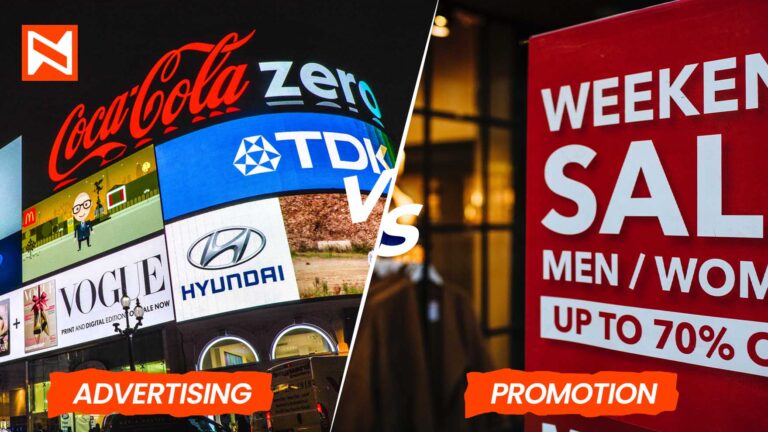People often use the phrases “advertising” and “promotion” interchangeably because they believe they refer to the same thing. So although advertising and marketing do have certain similarities, they also vary significantly. One of the four pillars of the marketing mix (product, location, promotion, and pricing) is promotion, which focuses on educating the public about the company’s offerings. Advertising, direct marketing, public relations, personal selling, etc. are all forms of promotion. To be clear, advertising is a promotional instrument whereas promotion is a marketing strategy. Through the use of examples, definitions, and explanations, we want to clearly illustrate the key distinctions between advertising and promotion in this essay.
Definition
Promotion
All of the actions that inform consumers about a product, brand, or service are referred to as promotions. The purpose of promotion is to increase consumer awareness, draw in new customers, and persuade them to choose your product over that of your rivals. It is one of the marketing mix’s four components. There are several ways to promote products and services, including advertising, press releases, and consumer promotions including free samples, sweepstakes, rebates, incentives, and trial offers.
Advertising
Advertising is a means for communicating with the customers of a product or service through carefully chosen and funded media. It is a method of marketing that makes it easier to get a certain message out to lots of people quickly. A strategy for convincing prospective consumers to purchase the product is called advertising. Advertisements are distributed via a variety of media, including radio, television, newspapers, magazines, billboards, posters, walls, buses, etc.
Types of Promotion
Direct Marketing
Prospects and prospective clients are the primary focuses of direct marketing. The majority of businesses employ the direct marketing strategies of social media marketing, internet marketing, and email marketing.
Sales Promotion:
The primary goal of sales promotion is to increase sales and encourage consumer spending. Additionally, it plays a significant role in educating potential consumers about new items and winning back lost clients in addition to helping to increase revenue. Samples of goods, vouchers, etc. are examples.
Advertising
It determines how the market will see the brand name and aids in brand development. Additionally, advertising has a broad reach for the message you want to convey to your audience.
Personal selling
Personal selling is when a business sends one of its representatives to personally pitch a product to a customer. Through this two-way dialogue, the business receives honest criticism, fosters trust, and draws in more customers.
Public Relations:
Controlling the dissemination of information between a brand and the general public is a difficult task. However, a skilled PR division may improve the company’s reputation and restore it in the event of a disaster.
Types of Advertising
Newspapers and magazines:
People still look for their daily newspaper or a printed copy of a magazine, therefore this kind of advertising may help you reach a broad spectrum of clients. A specialized newspaper or magazine increases the likelihood that prospective clients will learn about your company.
TV, radio, and podcasts
TV, radio, and podcasts are excellent media outlets for advertising if your company wants to reach a broad audience. Additionally, messages that are often repeated have the ability to grab attention and draw in new customers.
Outdoor Advertising.
One of the finest methods to capture your client’s attention while they are on the road is via outdoor advertising. Due to their widespread visibility every day, large billboards and transit advertising (posters on buses, taxis, metros, etc.) aid in increasing brand awareness.
Email Marketing
With an emphasis on the brand’s current clients, the direct mail strategy should be more personalized and treat devoted customers like VIP insiders. A precise mailing list is like a gem, but companies must come up with best practices for using such a priceless resource.
Online Advertising
One of the least costly and cost-effective forms of advertising is online advertising. Additionally, regardless of the primary campaign aim, it enables firms, particularly small enterprises, to reach a worldwide audience even with a limited budget.
Objective
Promotion
The fundamental goal of marketing is to boost short-term sales for the brand. Businesses do this by raising consumer demand for a brand’s products and services in order to boost sales and profit margins. Utilizing consumer incentive strategies, for instance, tracks what a client buys and generates discounts for like items. Customers are encouraged to spend more money by purchasing more or more costly items as a result.
Advertising
The usage of advertisements primarily serves a few notable objectives. For instance, announcing the launch of a new product or service to persuade clients that your offering is the best. Another goal is to improve brand recognition and increase sales by placing a focus on things like product quality, customer service, and special features. Additionally, there are “reminder advertisements” that reaffirm the brand message to an established market in an effort to preserve top-of-mind awareness and defend against rival brands.
Key variations
The following are, in brief, the main distinctions between advertising and promotion:
1 Communication Type
Advertising is often one-sided. Your intended audience sees or hears the message you give them. Promotion may be reciprocal. You might propose coupons customers can use at your shop or request that they “like” you on Facebook. When you advertise, your target audience often has to take some action that enables you to gauge the effectiveness of your marketing strategy. Sales income, cost per lead, and total customer value are just a few of the KPIs specific to advertising that needs to be monitored.
2 Cost
The cost of advertising is often higher, and frequently, but not always, a campaign will be designed and managed by an agency. It is possible to simplify and cut down on advertising. While funding an advertising campaign may be challenging for a small company, you may nonetheless advertise the enterprise. For instance, creating a Facebook page requires less expertise and effort than managing a TV ad campaign.
3 Time
In contrast to promotions, which are often short-term and have the primary goal of extending the sales period, advertising is typically long-term in duration and will lead to slower sales.
Despite their differences, marketing and advertising may work well together and have numerous advantages for your firm. Consider your desired outcomes and if they are time-sensitive before considering your financial capabilities. This will affect your selection between an advertising campaign and proactive marketing, or possibly even both.
4 Objective
While promotion comprises a series of actions that raise interest in a brand, product, or service, advertising draws consumers’ attention to a particular good or service.
5 Results
The usual period for outcomes also reflects the long- and short-term disparities between the two. You often have to wait while launching an advertising campaign to see the results in new clients and repeat business. On the other hand, promotional efforts often result in the launch of new firms right away.
Promotion vs Advertising
Promotion
Time Long-Term
Cost Cost Expensive
Suitable for Medium-size to large businesses
Example Newspaper, TV, and radio ads online ads
Objective brand development, consistency
Communication One-way
Advertising
Time Short-Term
Cost less costly
Suitable for Small and big businesses
Example giveaways, freebies, and discounts
Objective Increased repurchase rate, loyal customer base, and bringing in new customers
Communication Two-way
Final Thoughts
Whichever marketing method you choose is subject to understanding who the target demographic is and how far they should be reached. Understanding the costs and expenditures connected with selecting one of them is crucial.
Therefore, it is crucial that the marketing staff of the company establish the essential objectives and be SMART in selecting the appropriate marketing approach. However, in general, a company may successfully accomplish its objectives with the aid of both advertising and promotion!







![Top 10 Best PR Campaigns of 2022 [Winning the PR Game]](https://naumandigital.com/wp-content/uploads/2023/02/7-600x400.jpg)
![Target Audience vs Target Groups [Explained]](https://naumandigital.com/wp-content/uploads/2023/02/17-600x400.jpg)
